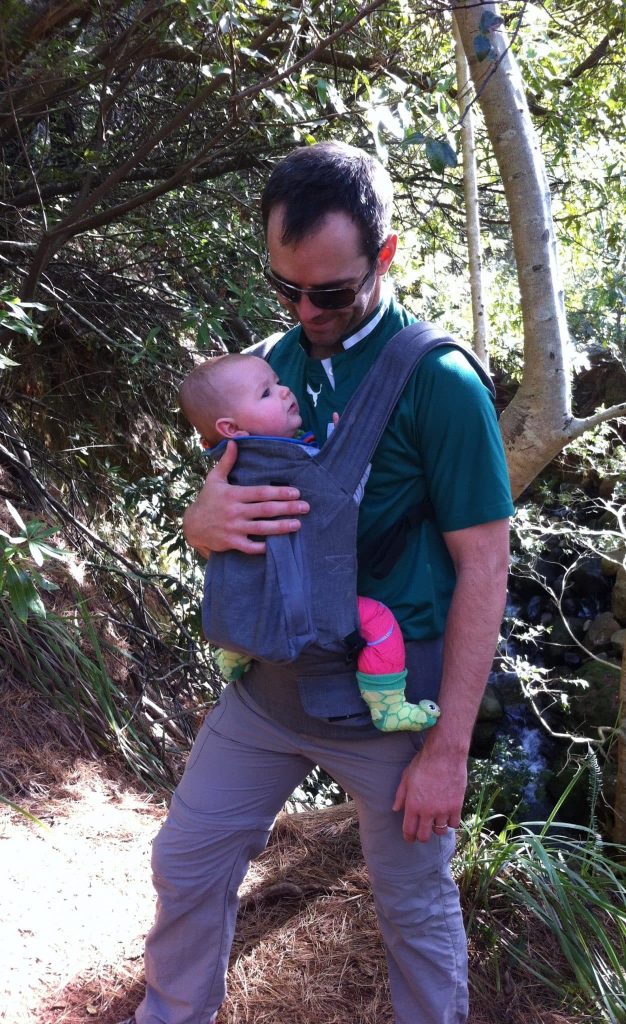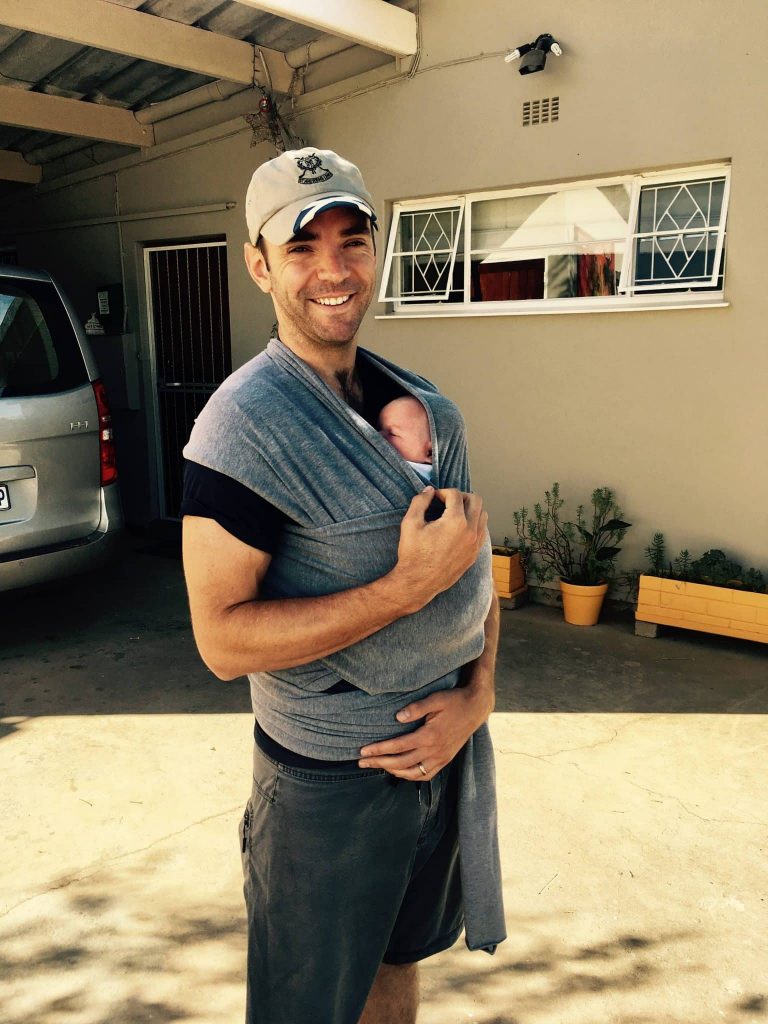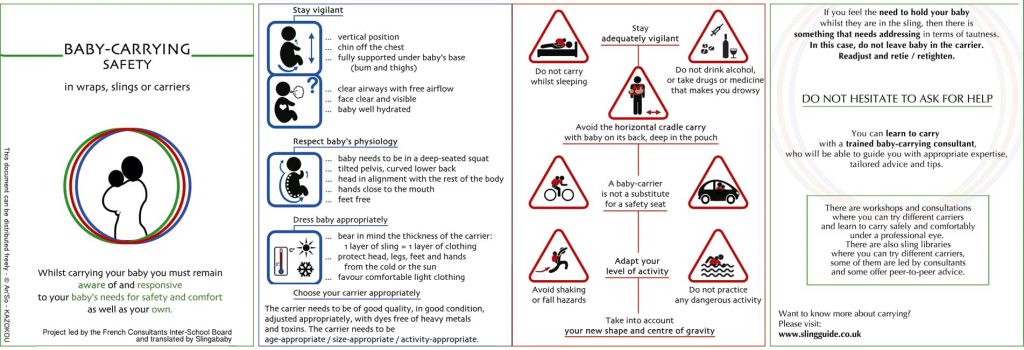Over the years, my frustrations grew as I could share the benefits of Chiropractic care but I was limited because I couldn’t actually do the Chiropractic adjustments! I had considered going to study to become a Chiropractor but we already have one of those in the family – you will meet my husband shortly.
I have been an advocate of babywearing since before my children came along and have helped many families with making it a more comfortable, more enjoyable experience so when I heard that there was a Babywearing School from the UK coming to South Africa to teach a consultant’s course, I immediately knew this was what I was going to do. It was perfect timing too – my youngest was going to be 18 months at the time of the course so I felt more relaxed – notice I said more relaxed and not completely relaxed – leaving her in the care of my husband, family and friends. I hadn’t been away from her for more than a few hours at a time so 10 hours a day was a massive jump.
In October 2018, Lorette from Slingababy landed in Cape Town and after an intense 4 days, I had completed my course. I learned, unlearned and relearned a lot! One of the things that is requested of us in order to gain our full certification is to produce something that will benefit the greater babywearing community.
Interview With a Chiropractor About Babywearing
It was only a natural choice for me to then write about Chiropractic and babywearing. So, I decided to interview my husband, Dr Greg Venning, to find out more about Chiropractic and how it links to babywearing.
Eils: Greg, most people know Chiropractic for back pain, neck pain, headaches and injuries, but we know it goes way beyond that. Please can you explain the link between the spine, nervous system and the brain.
Greg: Your brain and nervous system is the one thing in your body that regulates everything else. Nothing in your body is NOT influenced by your nervous system. The brain and nervous system co-ordinates everything in your body from breathing to hormone production and from immunity to muscles and movement.
If your health is a symphony and the organs of your body are the instruments that each play their tune, then the nervous system is the conductor. In this symphony, your health, life and human potential are directly tied to the rhythm, balance and harmony of this finely tuned system.
This system is so important and so delicate that it is encased in bone. The bones of your skull cover your brain and the bony rings of your spine protect your spinal cord.
What most people aren’t aware of though is that the body has a massive influence on the brain too!
80% of the background activity of the brain is generated by movement of your body. Movement and alignment of your body is a vital nutrient to the development, balance and health of your brain and nervous system.
Eils: Can you explain the different stages of spinal development and the link with neurological development?
Greg: There is a rule in biology: Structure affects function and function affects structure. That means that the nervous system (function) and the spine and pelvis (structure) have an intimate relationship.
When you are first born, your spine has one c-shaped curve running from your coccyx to your neck. As you learn to move in the world through your nervous system, you begin to form different curves. Your neck (cervical) and your lower back (lumbar) regions curve forward while your mid back (thoracic) region continues to curve backwards.
Without these curves, your nervous system cannot function optimally. A baby will not be able to hold their head up properly, to crawl well, to hold up their own body weight while sitting and walking patterns may also be affected.
These early movement patterns also play a strong role in how our brain works, in how we learn. Children who skip these stages of spinal development tend to have gross movement issues and also tend to have learning challenges like AHDA and dyslexia.
A nervous system under stress from a compromised structure will affect our overall ability to be healthy and with 90% of brain development happening by 5 years old, it is especially important to provide optimal conditions for the developing baby’s spine, from birth, through infancy and beyond.
Eils: This co-insides with what babywearing educators recommend – that we need to be mindful of how we carry our babies. The aim is to support the natural ‘C’ shape curve that they have been used to in-utero when they are newborn and facilitate the development of spinal curves as they grow older. If you were to carry a baby in a forced upright position or even put their spine into extension, this can place unnecessary stress on the developing spine which is why selecting a safe and appropriate carrier for your needs, is important.
Eils: So how does this relate to a baby’s need for contact with their mother (primary caregiver)?
Greg: As we grow and develop, safety is the primary concern of the nervous system. If we perceive a threat, then the nervous system will create the physiology and psychology of stress and defence as our main mode of operating. If we perceive safety, then we have growth and repair as our main modes.
If a baby is left on their own a lot, they may ‘hard wire’ more defence-oriented connections in their developing nervous system. An environment of nurture and connection, which physical contact with a care-giver creates, may wire in the neural connections of growth.
Eils: Can you explain a little more about how separation effects neuro development?
Greg: In defence, we tend to view the world and other people as threats. We tend to function from fear. In this mode, deep, trusting relationships are harder to form. We tend not to be adaptable to stressful situations and can even be more susceptible to infections and chronic conditions like heart disease or diabetes.
In growth, we find it easier to form genuine human interactions, to be vulnerable and to be accepting of vulnerability. We display more compassion and are able to be more patient. We tend to show more signs of adaptability in our mental and emotional approach to life and be more resilient to health conditions.
Eils: Interesting. What are some of the health concerns that are now being seen in babies?
Greg: Common things we see in babies are misshapen heads (plagiocephaly), babies who cry and aren’t consolable (often called colic), hip dysplasia, digestive issues, postural problems (often labelled as ‘low tone’) and ear infections.
Eils: Do you think that babywearing could help prevent some of these health issues?
Greg: As many of these issues are linked to the spine and nervous system and babywearing promotes better spinal health, it seems that it would at least limit if not benefit and prevent some of those issues.
Eils: You mention plagiocephaly, what is that? How does it happen and what effects does this have on the health of a child?
Greg: The human skull houses the brain, which floats inside it. The fluid the brain floats in is called CFS and delivers all the nutrients the brain and spinal cord need and take away all the waste. If the shape of the skull is distorted, it may disturb the circulation of the CSF and have consequences for the function of the nervous system.
A distorted skull shape is called plagiocephaly and it appears to be directly related to brain function: the worse the distortion, the more it affects the brain. There is some evidence to suggest that the worse the plagiocephaly, the more it negatively impacts on IQ scores later in life.
There seems to be two types of factors that can drive plagiocephaly; internal and external. External factors include things like baby being in a position in the womb that causes stress on their head, long and difficult delivery, birth trauma, the use of forceps and vacuum extraction. It can also include baby lying in one position for long periods like being on their back or in a car seat. Falls or bumps to the head and spine are also factors to be considered.
Internal factors that can drive plagiocephaly are subtle misalignments of the base of the skull or spine setting in place uneven growth of the skull and vitamin D deficiencies that mean that the bone is weaker and more susceptible to these other internal and external forces.
Eils: How can babywearing help to prevent plagiocephaly?
Greg: Since babywearing reduces the amount of time baby could be lying in one position with pressure on the head, there would be less of the external force on a baby’s head to deform the shape.
Babywearing also stimulates baby to use their neck muscles appropriately. The activation of these muscles creates a pulling force that seems to help mould good skull shapes.
Eils: You also mentioned hip dysplasia, and it’s something that gets mentioned in babywearing communities often. What is hip dysplasia?
Greg: Hip dysplasia happens when the socket in the hip that the ball shaped head of the thigh bone (femur) fits into, is too shallow. This makes it very easy for it to click out of place. If untreated, it could lead to significant problems.
This is a very interesting area. Traditionally we thought that hip dysplasia was congenital, that babies were born with it, but now it is clear that this condition can also develop during the first year of life.
Note: The healthiest position for the hips is for the hips to fall or spread naturally apart. The baby’s natural position should always be respected so if baby is still curled up, respect that, if their hips are opening, respect that. The preferred position for your baby to sit in a carrier is with their bottom lower than their knees, hips spread appropriately for their age, and knees bent.
Eils: Can wearing your baby in a carrier that doesn’t support the healthiest positioning cause hip dysplacia?
Greg: Healthy positioning of a baby’s hip avoids creating inappropriate stress that can lead to hip dysplasia. If a baby is carried in ways that puts more pressure on its hips, that can certainly contribute to hip dysplasia.
Eils: So, if a parent is concerned about their child and plagiocephaly or hip dysplasia who can they speak to?
Greg: Chiropractors who have trained to work with children are trained to be able to check for hip dysplasia and plagiocephaly, manage it and refer to specialists when necessary.
Eils: What are some of the other things to look out for when carrying your baby that may indicate that you need to visit a Chiropractor?
Greg: In the baby, the signs that there may be spinal stress that a chiropractor is best suited to help with are:
- Favouring turning their head to one side
- Favouring feeding on one side more than the other
- Head and neck stuck to one side
- Arching their back a lot
- A persistent clicking sound from their hip
- Persistent scratching or pawing at one or both ears
- Misshapen head – flat spots, cone-shape…
- Uneven sized eyes
- Eyes not on same level
- Ears not on same level
Let’s not ignore the wearer either. We regularly disregard issues in our own bodies in favour of the needs of our little ones. The person carrying the child could have their own set of spinal stress under the surface. Spinal stress will eventually affect nervous system function and it is important to recognise minor irritations before they escalate into bigger problems. Adding the weight of the child might help you notice those issues more.
Be on the lookout for:
- Lower or mid back pains when carrying
- Neck pains or shoulder when carrying
- Headaches related to carrying
- Jutting your hip out to the side when carrying (normally seen in an in-arms carry but can be seen in a side-carry with a carrier that isn’t correctly fitted)
- Your head going forward when carrying
- Your hips going forward when carrying
It is especially important to pay attention to the mother’s body after pregnancy and birth; hormone changes causing relaxed ligaments can increase risk of injury.
Eils: As a Chiropractor, do you recommend babywearing to your practice members?
Greg: Yes, with what we’ve discussed here, it makes sense to marry babywearing with Chiropractic for optimal spinal and neural development. We enthusiastically advocate babywearing to the families in our practice. Beyond spinal health, babywearing can foster a closer, more intimate, more trusting bond between a baby and its care givers. There tends to be less crying, fussing and ‘colicy’ behaviour in the short term and evidence suggests that the children grow up to be more integrated individuals in the long term.
Eils: Please share with us the highs and lows of your journey as a babywearing dad.
Greg: My journey started a little reluctantly. I loved the concept of babywearing but hadn’t had any exposure to the details of it and was aware that it could be damaging if done incorrectly so I was weary as a parent and not very able to help parents as a professional.
Dads can sometime feel left out. We’re biologically limited as care givers early on and so can feel like we don’t get the close contact mums usually do if they are breastfeeding. If we have a tough time settling a crying baby and our partner is the only one who can, then that can place strain on a relationship too.
My experience of babywearing is that it gave me more of that sense of physical closeness and I feel that has helped me bond with my girls on a different level. It also made it much easier for me to help my girls settle and sleep on me which gave my wife (you) some breathing space.
With our first daughter, we used a pram a lot in the first few months and only got into babywearing when she was about 3 months once we were more confident in using the carrier we had. I loved being close to her but I it wasn’t always comfortable. We used a buckle carrier (I didn’t know the types back then) and I loved being able to take her for walks in the woods, especially as a back-carry when she got older. It meant we could explore what our beautiful city has to offer without being restricted by prams and access issues.
By the time we had our second daughter, we had learned a lot of what not to do and my amazing, beautiful, phenomenal wife had done a ton of research. She taught me how to use wraps for when she was very young, I loved this! Having her snuggled into my chest was such a special feeling. Learning how to properly work a wrap wasn’t without its frustrations, but I was determined and the payoff was worth it.
We transitioned to the buckle carrier as she got older but this time no more discomfort because we’d made some seemingly small changes that made a big difference.

Dr Greg carrying Breah in an ‘African Baby Carrier’ buckle carrier on a hike in Newlands Forest.

Dr Greg carrying Imogen in an unbranded stretchy wrap at a couple of weeks old, in Clan William in 40+ degree heat.
All in all, my relationship with my girls is strong, my ability to parent is better and I advocate babywearing as a professional.
So How do Families Find the Best Carrier for Them?
The perfect carrier for your family will depend on multiple factors: age of the child, size of the child, length of time they will be carried and budget, are just a few. There are many, many different carriers out there. Find the one that best suits you and your family’s needs that takes into consideration the health of you and your baby’s spine. Talk to other people who carry their babies, borrow carriers from a friend or a local sling library, go to your nearest sling meet up, make an appointment with your nearest carrying consultant.
Age Appropriate Positioning for Babywearing

Baby Carrying Safety

Peak Chiropractic Centre located in Claremont are family-friendly chiropractors focused on relieving aches, pains and posture correction. We offer in-house X-Ray facilities.


